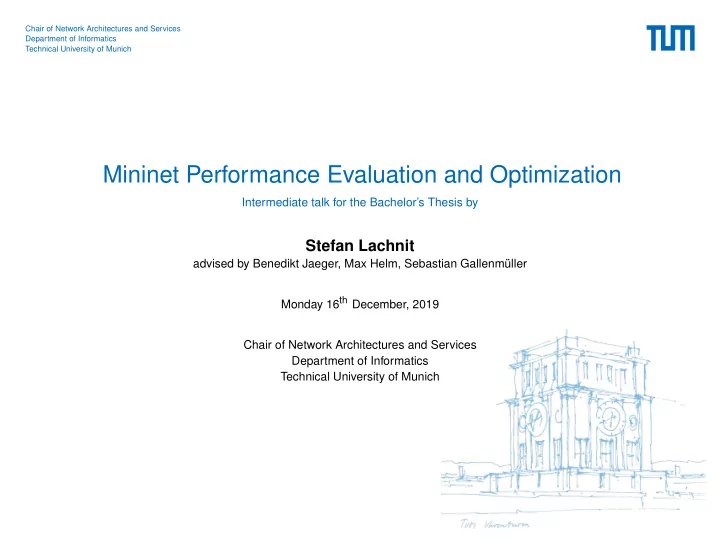

Chair of Network Architectures and Services Department of Informatics Technical University of Munich Mininet Performance Evaluation and Optimization Intermediate talk for the Bachelor’s Thesis by Stefan Lachnit advised by Benedikt Jaeger, Max Helm, Sebastian Gallenmüller Monday 16 th December, 2019 Chair of Network Architectures and Services Department of Informatics Technical University of Munich
Agenda 1. Motivation 2. Related Work 3. Benchmark Toolchain 4. Example Benchmark: Impact of IPv6 on IPv4 measurements 5. Future Work Stefan Lachnit — Mininet Performance Evaluation and Optimization 2
Motivation Mininet: • Network emulation tool (multiple hosts and switches on one server) • OpenFlow based virtual switches • Uses Linux network namespaces • Reproducible and portable network experiments Goals: • Analyze performance and resource usage • Detect performance bottlenecks • Find measures to optimize the performance of Mininet Stefan Lachnit — Mininet Performance Evaluation and Optimization 3
Related Work Handigol Nikhil et al. - P . Isaia et al. - Perfor- D. Muelas et al. - Assess- Mininet Performance Fi- mance benchmarking of ing the Limits of Mininet- delity Benchmarks [4] SDN experimental plat- Based Environments for form [2] Network Experimentation [3] � � � Ping Data (RTT, Packet loss, etc. ) � � Bandwidth Measurement � � CPU usage, RAM usage � � � Multiple network topolo- gies � � Analyse performance Bottlenecks when scal- ing number of network elements � Comparison of different hardware hosts � Hardware Optimizations (Core isolation, CPU pin- ning) � Comparison to real net- work Stefan Lachnit — Mininet Performance Evaluation and Optimization 4
Benchmark Toolchain Builds different network topologies using Mininet and scale the number of network elements • Line Topology host 1 switch 1 switch n host 2 • Star Topology host 1 host 2 host n Stefan Lachnit — Mininet Performance Evaluation and Optimization 5
Benchmark Toolchain Runs automated tests on the emulated network • Ping (one to one, simultaneous) • Iperf (TCP , UDP) Records performance metrics • CPU usage • RAM usage • Cache misses • Number of packets at the OpenFlow controller • Network startup/teardown time Stefan Lachnit — Mininet Performance Evaluation and Optimization 6
Results: Impact of IPv6 on IPv4 measurements Setup • Intel Xeon E31230 (4 cores/ 8 threads); 16 GB RAM • Debian Buster (Kernel 4.19.0-6-amd64) • Topology: Line Topology switch 1 switch n 10 . 0 . 0 . 1 10 . 0 . 0 . 2 • Tests • Ping: 100 packets over 5 seconds • IPerf: 100 Mbit/s UDP traffic (512 byte packets) for 5 seconds • Presented performance metrics • CPU usage • Packets at the OpenFlow controller Stefan Lachnit — Mininet Performance Evaluation and Optimization 7
Results: Impact of IPv6 on IPv4 measurements 4 , 000 ping time (in ms) 3 , 000 2 , 000 1 , 000 0 0 5 10 15 20 25 30 35 40 45 50 55 60 65 70 75 80 85 90 95 100 number of switches Stefan Lachnit — Mininet Performance Evaluation and Optimization 8
Results: Impact of IPv6 on IPv4 measurements 4 , 000 ping time (in ms) 3 , 000 2 , 000 1 , 000 0 0 5 10 15 20 25 30 35 40 45 50 55 60 65 70 75 80 85 90 95 100 number of switches 20 , 000 IPv4 packets at the controller IPv6 ARP 15 , 000 10 , 000 5 , 000 0 0 5 10 15 20 25 30 35 40 45 50 55 60 65 70 75 80 85 90 95 100 number of switches Stefan Lachnit — Mininet Performance Evaluation and Optimization 8
Results: Impact of IPv6 on IPv4 measurements 0 . 4 IPv6 enabled IPv6 disabled 0 . 3 CPU usage 0 . 2 0 . 1 0 5 55 75 0 10 15 20 25 30 35 40 45 50 60 65 70 80 85 90 95 100 number of switches Stefan Lachnit — Mininet Performance Evaluation and Optimization 9
Results: Impact of IPv6 on IPv4 measurements 0 . 4 IPv6 enabled IPv6 disabled 0 . 3 CPU usage 0 . 2 0 . 1 0 5 55 75 0 10 15 20 25 30 35 40 45 50 60 65 70 80 85 90 95 100 number of switches 0 . 6 0 . 5 ping time (in ms) 0 . 4 0 . 3 0 . 2 IPv6 enabled 0 . 1 IPv6 disabled 0 5 55 75 0 10 15 20 25 30 35 40 45 50 60 65 70 80 85 90 95 100 number of switches Stefan Lachnit — Mininet Performance Evaluation and Optimization 9
Results: Impact of IPv6 on IPv4 measurements • Interfaces of virtual switches get IPv6 address through SLAAC • NDP packets (router solicitation, neighbor solicitation) are sent by these interfaces • Every time a multicast NDP packet reaches a switch it is sent to the controller Stefan Lachnit — Mininet Performance Evaluation and Optimization 10
Future Work • Analyze the effect of disabling hardware features (e.g. SMT) [1] • Test effects of core isolation and CPU pinning • Record traffic for additional analysis • Test other traffic generator (D-ITG) Stefan Lachnit — Mininet Performance Evaluation and Optimization 11
Bibliography [1] S. Gallenmüller, J. Naab, I. Adam, and G. Carle. 5g qos: Impact of security functions on latency. ArXiv , abs/1909.08397, 2019. [2] P . Isaia and L. Guan. Performance benchmarking of sdn experimental platforms. In 2016 IEEE NetSoft Conference and Workshops (NetSoft) , pages 116–120, June 2016. [3] D. Muelas, J. Ramos, and J. E. L. d. Vergara. Assessing the limits of mininet-based environments for network experimentation. IEEE Network , 32(6):168–176, November 2018. [4] H. Nikhil et al. Mininet performance fidelity benchmarks. October 2012. Tech. Rep. Stefan Lachnit — Mininet Performance Evaluation and Optimization 12
Recommend
More recommend